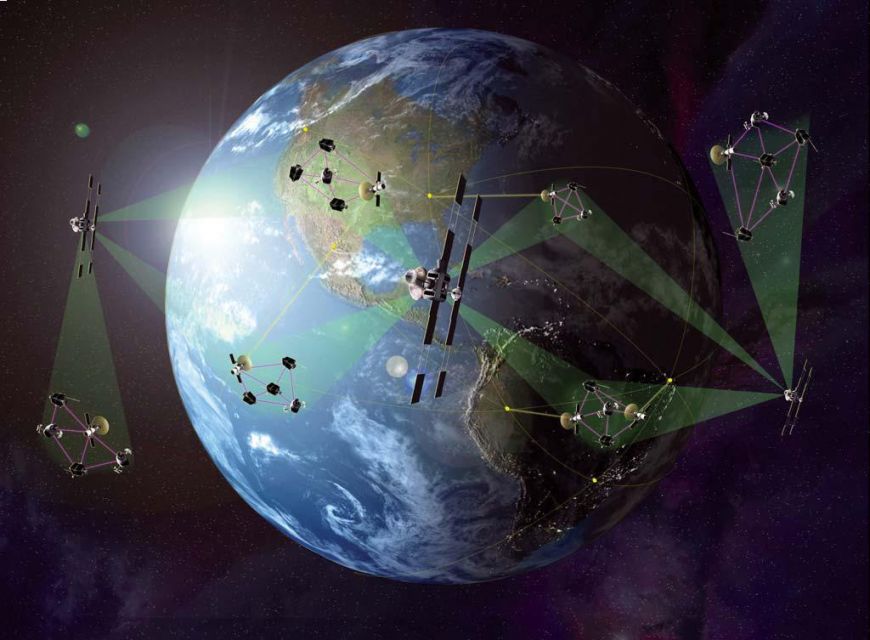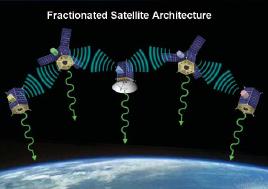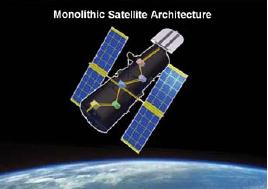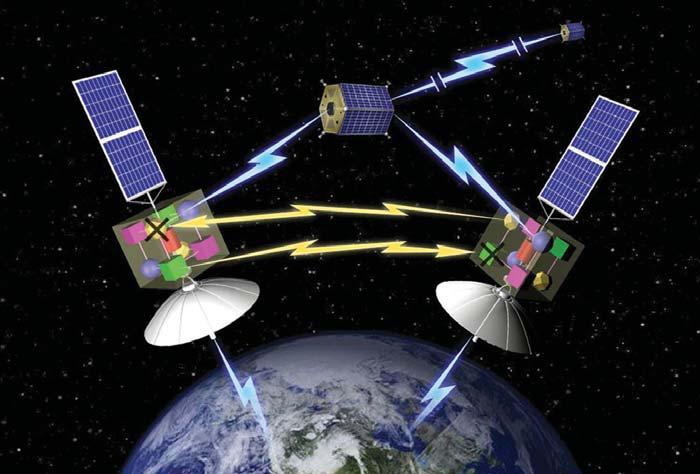In 2012, the USA will launch an experimental satellite based on split modules, which will function together as a large monolithic satellite only thanks to a wireless communication network and a fail-safe protocol similar to the Internet Protocol

These days, the first phase of an extraordinary program by the American Defense Advanced Research Projects Agency (DARPA) is about to be completed, which according to some of those involved is expected to be at least as significant as the ARPANET project from the 60s, from which the Internet known today grew.
The agency is testing a new idea in the field of space, designed to formulate an answer to the inherent weaknesses in the military space arm of the United States. Weaknesses arising from the high price of any military satellite - intelligence, navigation or communication, the long time that passes between placing the order, launching and providing service to the customer, and the inability to repair faults discovered after the launch into space.
In addition, the United States is troubled by the high vulnerability of its space arm, which depends on the functioning of very large satellites, and the difficulty in making changes in the missions of the space platforms that have come into use or upgrading them according to new requirements.
Aviation in the structure

A year ago, the project was launched under the name System F6, when DARPA announced that it wanted to provide an answer to all these weaknesses by developing a new idea of a space platform: it would not be based on a large monolithic satellite with a lot of hardware and software, but on the principles of a wireless Internet network.
After many studies were done in recent years that proved the ability to make satellites orbit the Earth in a tight and controllable structure, DARPA decided to advance the idea one more step, and to test what would happen if instead of satellites orbiting the Earth in a structure, it treated the space platform as different modules orbiting the Earth in structure.
The new idea is called Fractionation. This word is not found in the dictionary, but it is derived from the word Fraction. It means that there is no need to send complete systems into space, but different components, which only after communicating with each other via a wireless Internet-like network, will be able to function together as a complete system. The new satellite can be called a "split satellite", or even a "virtual satellite".
Resource sharing

For example, today each satellite includes a number of basic systems, regardless of the payload it carries, such as position detection systems, star detection systems to estimate the direction of its movement, control and control computers, memory for storing information, solar cells for energy supply, and more.
The virtual satellite will be a collection of resources linked through the network. One module will be able to provide processing resources to the other modules through the communication network, another module will be able to serve as the database and storage for the system, another module will provide energy which it will transmit through microwave transmissions, optical technologies or other technologies to the other modules, and a fourth module will be able to perform the calculations of the satellite's position and movement the virtual for all other modules.
When it comes to Mated himself, the idea is even more enticing. Today the space station and the space platform are connected to each other. Each of them imposes constraints on the other, which affect the cost and response time. When the satellite is treated as a wireless network, where the metad is another end point like any accessory in the national internet network, the platform can be launched before the development of the metad is completed, the metad can be replaced with an existing platform or metads can be added according to the changing requirements.
38 million dollars
In March 2008, the first phase of the project began, amounting to 38 million dollars. As part of it, a number of companies won budgets to develop initial ideas and a method for evaluating the function and determining the efficiency of the virtual satellite.
The Northrop-Grumman company received a budget of 6.2 million dollars to develop a wireless communication network between satellites, a distributed command and control system and network protocols. With the completion of the first phase, which is expected in the coming weeks, Northrop Grumman will present basic communication capabilities, initial planning of the wireless network and business analysis of the technology. According to the plan, in the next three phases of the plan, it will formulate the idea for full development and production of the network, to be installed in the group of experimental satellites.
IBM and Orbital Sciences received a budget of 13.6 million dollars for the development of technologies in partially overlapping areas: a data communication network with extremely high survivability and reliability, reliable wireless communication technologies, fault-tolerant distributed computing technology, technology for the wireless transmission of energy from satellite to satellite, and self-driving technologies of Satellite clusters.
In addition, they will develop, in cooperation with other parties and the academy, an economic model for assessing the risks and cost versus benefit of the split satellite, and will build a cluster of linked computers that allow simulating the operation of the split satellite. Boeing and Lockheed Martin jointly received a budget of 19 million dollars to compete to develop an initial idea for the hardware of the satellites, which will eventually be selected to participate in the experiment.
Seven small satellites

In an experiment that will probably be conducted towards the end of 2012, small satellites will be launched into space using commercial launchers, which will launch the modules at different times and from different places. The five modules will meet in space, and will begin a series of independent actions to establish a wireless communication network, get ready in the structure, distribute resources and perform tasks that will be dictated by the experiment.
The satellites will be organized in the format of a new architecture called Pleiades, after a star cluster that got its name from the seven nymphs accompanying Artemis, the goddess of the moon and the hunt in Greek mythology. The Pleiades array will contain seven modules: five modules weighing 225 kg each and two modules weighing 75 kg.
The array is intended for a low-altitude space mission carrying photographic sensors. The sensors are in different technological stages, one of them is very old, another is only in the stages of technological development and the third has a very short life cycle. Combining them together helps to obtain a new type of information. In addition to photography, the system will be asked to perform image processing in space on a large scale, provide massive storage capabilities and allow for an immediate change of mission to respond to unexpected needs.
It is interesting to note that in DARPA's assessment, the technological foundations on which the idea is based are not related to space engineering, but rather to the fields of information and communication:
- A communication network with the ability to establish itself
- Reliable wireless communication technology
- Ability to transfer energy wirelessly
- Operation in the format of a cluster of computers
- distributed computing
The economic model to justify the virtual satellite idea is based on the fact that launching small satellites is cheap and available with minimal notice. The critical points in the satellite life cycle are: delay in the development and construction of the satellite, failure in the launch, and malfunction in space. In these three points the split satellite has a substantial advantage.
survivability
Unlike a monolithic satellite, where a delay in the development of the satellite delays the launch, the split satellite can be launched even before the satellite, or a certain component of the satellite, is complete, and attach it to the network after its construction is completed.
The most significant savings are related to launch failure. Unlike a monolithic satellite, the split satellite is launched into space through a series of launches of small modules. That is, there is not a single failure that can delay the plan until a replacement satellite is built, as was the case following the failure of the Israeli Ofek 6 satellite. At most there is a delay in the launch of only one of the modules.
Today, a malfunction in space, even of a subsystem, can completely disable a monolithic satellite. In a split satellite, it can damage only some of the functions, since the other normal modules will continue to perform their task.
The significance of these factors is not only economic. They express the military objective behind the program: a fragmented satellite is extremely reliable, it is very difficult to destroy it or disable it completely, and performing repairs in space (replacing a damaged module) is possible and even reasonable.
The satellite is the network
It is not for nothing that DARPA compares the System F6 project to the celebrated ARPANET project. When the split satellite is in the air, there will be no obstacle to connect additional modules to it ("additional "end points"), and create an array of 10, 20 or 100 satellite modules.
Later, it will be possible to link several virtual satellites that include several modules each, and create a network of hundreds of endpoints. And when this network begins to operate, any body that is allowed to connect to it will be able to launch into space only the module it is interested in, and link it to the emerging network. Just like today you connect a server or a computer to the Internet and thus increase it almost without limit.
At this point, most likely, the accepted definitions will have already changed. The question "what is a satellite" will be almost completely open. Why almost? Since the most correct answer to the question of what a satellite is, will be a paraphrase of the old definition of Scott McNeely, the founder of Sun Microsystems, who stated already in the 80's that "the computer is the network". In 2020, if the project is successfully completed, the satellite will be the network.
More information on the Darfa website
The article is taken from WaveTech Magazine

18 תגובות
Thanks Michael for the help and good will!
Maybe this way we can save another pair of academics who work in office cleaning and are considering returning to the country of origin.
Chen T:
I'll see if I know anyone who might be interested, but I'd like to point out two things you could have improved in your response:
One is to write it as a response to the article "Free comments".
The second is to address the request to everyone and not just to me because someone else might be able to help.
Website editor Hello, I apologize for this message, but I am trying to help a newcomer and I would appreciate it if you would be patient with me 🙂
Chen T.
Hello Michael,
I know a young and talented chemical engineer with a master's degree in water engineering who immigrated to Israel recently from Colombia and has been looking for a job in Israel for a long time, and since he couldn't find one, he started working in office cleaning.
I know this is not the right forum to look for a job for, but I thought maybe you know someone or someones who are looking for a person with a lot of energy and motivation and modest requirements.
The size and also his name David Delrosa: 052.89.09.676
Chen T:
It's much harder than spoiling a satellite.
To destroy a satellite you only need to damage its essential parts (especially electronic circuits, lenses, mirrors, etc.).
As soon as these systems are hit, the satellite becomes space junk but does not cease to exist.
To thwart the danger arising from an asteroid you have to literally vaporize the whole thing or divert it significantly from its orbit.
It should also be understood that while the satellite has special antennas designed to absorb energy, the asteroid does not have such antennas.
on track
Michael, it is possible to melt/disintegrate an asteroid with a dangerous symbol for the Earth if a strong burst of energy can be focused, right?
Sorry Michael, Anonymous is Chen T, I didn't remember that I deleted the cookies 🙂
anonymous:
I guess all the scenarios you described are possible although some are difficult to execute.
I also assume that the system designers will do what they can to minimize the danger of the malicious scenarios in between (for example, by very precise directionality of the energy receivers and pointing them in a direction other than that of the Earth).
Michael, if it is possible to transfer energy from satellite to satellite, if too much is transferred, will the receiver burn up?
And further to that criminal thought: Is it possible to transfer a concentrated and precise burst of energy for the purpose of destruction, as a weapon? Or is it possible to transmit an extremely intense burst of energy to a very distant satellite that will receive it as energy? And if we sail with the imagination: is it possible to transmit information with the same planned energy wave burst, just as information can be transmitted on a laser beam?
It seems to me that the plan came in response to the Chinese experiment to destroy a satellite in space
At first glance, it seems that the truly revolutionary part is the transfer of energy from one satellite to another
Chen T:
In my opinion, there are such projects in the planning.
I don't remember where I read this, but I also came across a plan to deploy several telescopes in orbit around the sun and use the huge distance between them to greatly increase the resolution of the image.
Hello Michael 🙂
You are right about the location.
My question is why they don't produce small telescopes - like the Lunar ones - that in different locations in space will be able, by common computing power, to produce a wider and more accurate image than just one large and expensive one.
Exactly according to the Internet version of the satellites presented in the article, it is possible to do regarding space research. Imagine if they could possibly put 100 mini-telescopes into space, which lack the limitations of the atmosphere relative to telescopes on Earth. How important is the quality of the information provided from a hundred different perspectives and processing?
It is not clear:
The separation improves the situation in several ways.
Its simplest contribution is the ability to repair - if one satellite breaks down, a replacement satellite is sent with a replacement satellite and there is no need to replace the entire assembly.
Another contribution comes from the fact that an external body's impact on one of the satellites does not physically harm the others, while if they were one body, the transfer of the energy of the impact would cause an additional amount of damage on top of that caused by the impact itself.
From this fact, which is an advantage in itself, there is also another advantage of increasing the efficiency of doubling components for backup purposes.
When the satellite is one body, then external damage to one of the components will most likely cause damage to its backup component, while when the satellite is split - the backup is not damaged.
Chen T:
What is the advantage of a telescope on the moon over a telescope in space?
It seems to me that the lunar environment mainly creates disadvantages because at any given moment the moon hides half of the universe for each of the telescopes while in space the telescopes can look in any direction at any time.
When will a project of remotely setting up a telescope on the moon come up?
It is possible to build several super telescopes in space when their common computing power can obtain a lot of knowledge about what is happening in space from different angles and with different technologies.
In my opinion, the most innovative part of the article is the transfer of energy from one satellite to another.
If each such small satellite performs one specific and significant role in the array, how exactly will this solve the vulnerability problem? After all, it is enough that one such small satellite is destroyed or breaks down and the whole array stops functioning... So what exactly did they get out of splitting one satellite into several small satellites? Still one of them that goes out of action disables the entire array.
So what did we do about it?
No. This means that the first big satellite will be replaced by several small ones, the next one after it will already be replaced by only one small satellite, which does the job and receives the rest of the things from the first several small ones.
Don't we have enough space junk in space?
Such an approach will make each satellite large, which is not a problem to handle and burn
At the end of use, it will split into dozens of small objects
It's very crowded there anyway